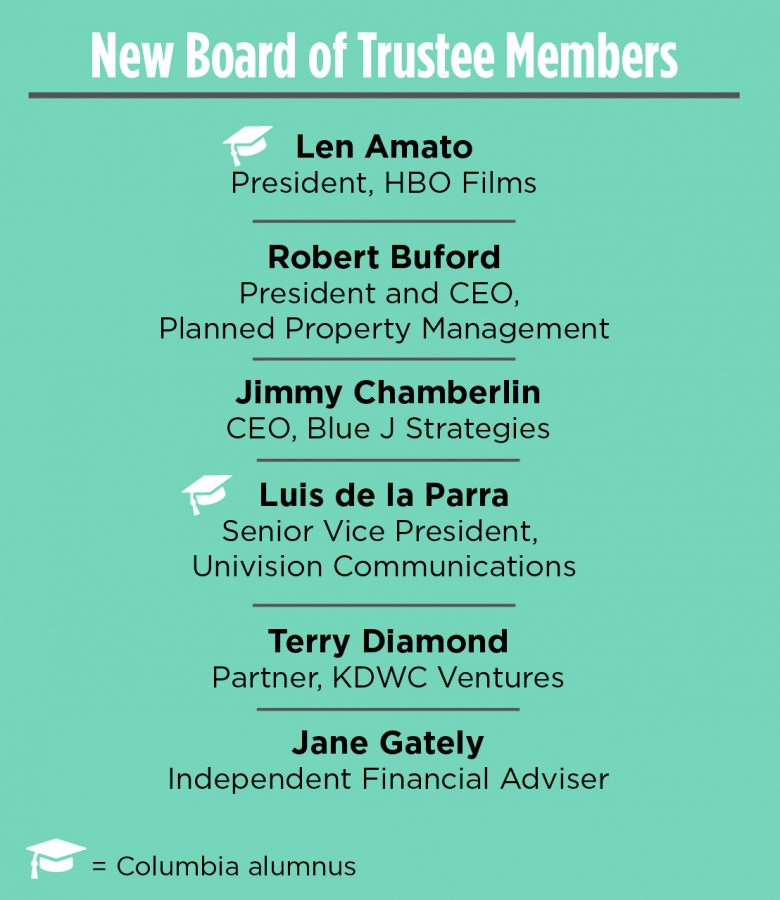College’s board of trustees revamped as old members leave
Board of trustees changes
April 4, 2016
After 23 years as a member of Columbia’s board of trustees, Howard Mendelsohn resigned from his position in February saying Columbia “is a different place” than when he first joined in 1993.
Mendelsohn, a 1949 speech alumnus, said he has greatly contributed to the college through scholarship funds and publicity even before joining the board.
“It is a long time [to have an] association with the school in so many different ways with so many different people,” Mendelsohn said. “It was a good run, and I did my part.”
The past year has brought great change to the board while five members resigned or completed their term, six new members were elected in the last academic year. The board has “formalized” its recruitment process by pushing to recruit more alumni and professionals in creative and technological fields, as reported Feb. 22 by The Chronicle. Since President and CEO Kwang-Wu Kim joined Columbia in July 2013, the board has lost 11 members and replaced the majority of the positions with new members. Two vacancies remain on the board of 40 members.
Recent inductees to the board include Len Amato, president of HBO Films; Robert Buford, president and CEO of Planned Property Management; Jimmy Chamberlin, CEO of Blue J Strategies; Luis de la Parra, senior vice president of Univision Communications; Terry Diamond, partner of KDWC Ventures; and Jane Gately, a financial independent advisor.
Mendelsohn, the president of Howard Mendelsohn & Company—a Chicago public relations consulting firm—has seen the college and its board of trustees evolve throughout the course of five of the college’s presidencies. He said he was close with all former presidents and board chairmen, except for Kim and Dick Kiphart, who currently chairs the board.
Mendelsohn said while on the board, he saw the college’s enrollment decrease, courses and departments consolidate, curriculums change and new ideas be implemented with the Strategic Plan.
“I have been very dedicated to Columbia,” Mendelsohn said. “I loved the stuff they were doing and the fact that we [used to be] an open enrollment kind of school. We helped a lot of kids who could have never gone to college in the way we operated then.”
John Gehron, a trustee since May 2004 who was recruited by Mendelsohn, said the board used to be more “informal” when times were easier with high enrollment, more high school graduates enrolling and cheaper tuition. He said the college has pushed board members to become more involved and dedicated.
“We don’t just want them for their name,” said Gehron, chairperson of the governance committee and member of the education committee. “We want them for what they can bring, not only to the school, but what they can offer to the students in their time and be accessible to talk to and guide students.”
Since last year, the board has recruited two alumni and has eight alumni members in total, according to the February 2016 updated board of trustees directory on the college’s website.
Joan Hammel, a professional vocalist and president of the college’s Alumni Association for seven years, said this is her last term on the board and she will be leaving the board in the Fall on the board to focus more on professional work.
“It has been a privilege to represent the alumni,” Hammel said. “There are endless amazing stories of [alumni]. Our alumni are truly inspiring.”
Having served on the board during the course of two presidencies, Hammel said each president has his own “style,” adding that there has always been a push for more alumni on the board, even though it was less of a priority previously.
Kim said he has pushed the board to recruit more alumni because they have a “different understanding and passion” for the college and are role models to students. He said he has also pushed the board to oversee the college at a policy level and not worry about its daily operations.
“Boards go through transitions,” Kim said. “There probably was a period of time where [recruiting trustees] was more about personality, and now of course that is important, but what skills do they bring, who do they know, what can they bring to the college that will help the college keep taking those next steps?”
During the transition to a more formalized process, the board’s governance committee did not fill vacant spots, which resulted in fewer new members because the committee was working to reassess the recruiting process of new members, Gehron said.
“It has always been a good mix of people, but they weren’t asking as much of us,” Gehron said. “In the past it was [like] we would like you to be on the board just because of the business you are in.”
Trustees can renew their term every three years and are asked to attend four meetings a year, sit on one to three committees and fulfill a $10,000 donation every academic year to be used in any area of the college.
Gehron said before electing trustees on the board, the committee makes sure the candidate can bring the time and energy needed to fully commit to the board, the college and its students.
“[The board] is a deep commitment to the school,” Gehron said. “Frankly, the more the board interacts with the students, the deeper that commitment becomes because we see the light shining out of these students’ heads.”
The board continues to evaluate the college’s decreasing enrollment, issues of diversity among board members, new ways to stay relevant to current and prospective students and how to keep Columbia accessible to creatively driven students who would not likely be accepted to other colleges, Gehron said.
“We want to be able to allow this doorway to the future for people of creativity who may not fit the normal mold of the student,” Gehron said.








